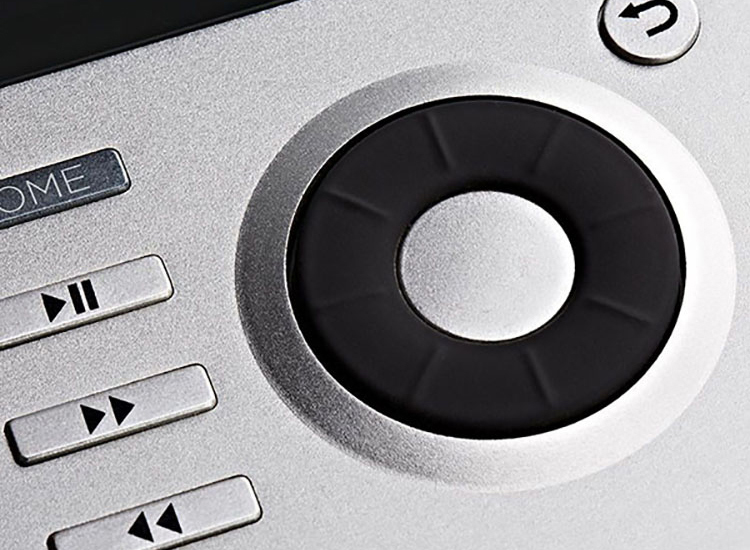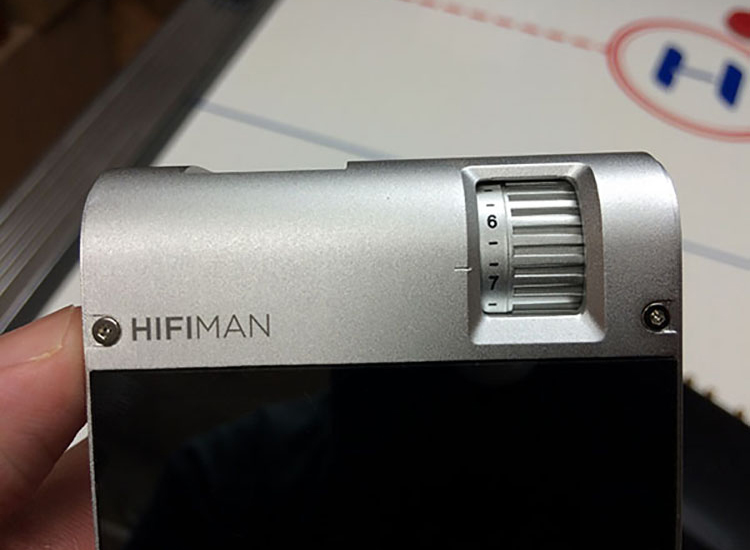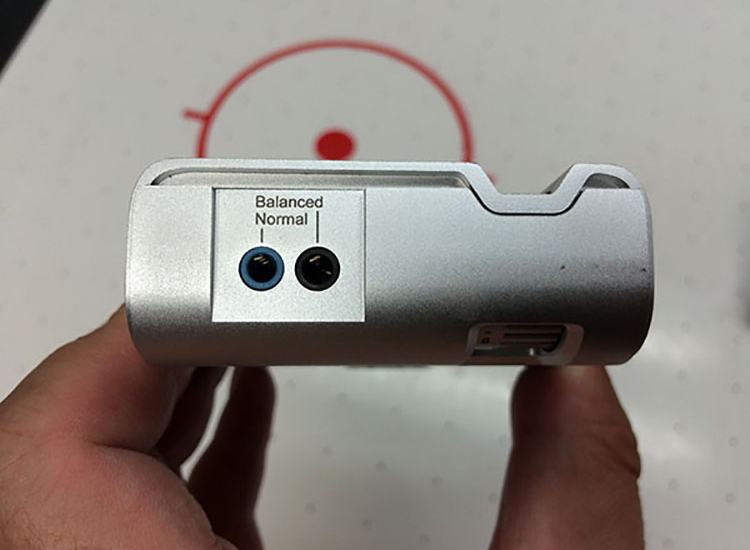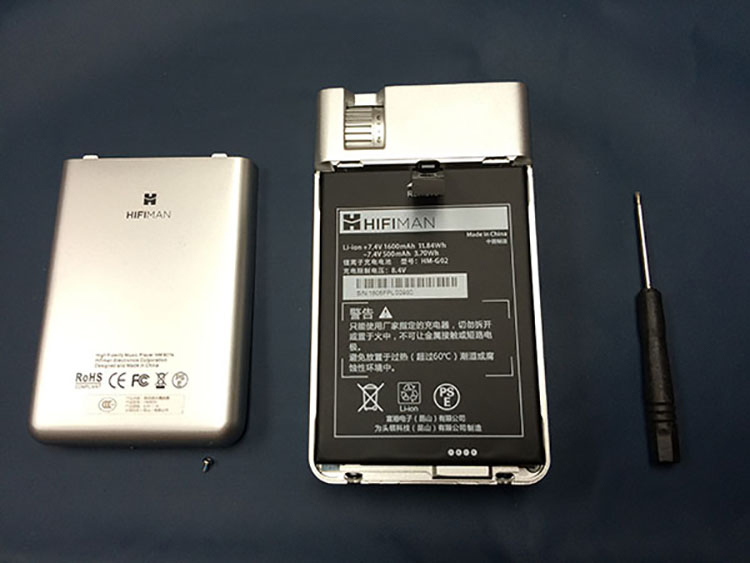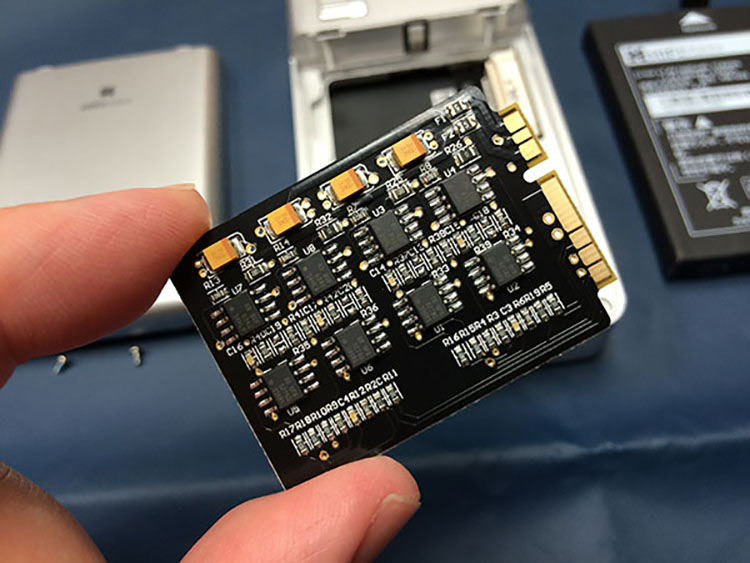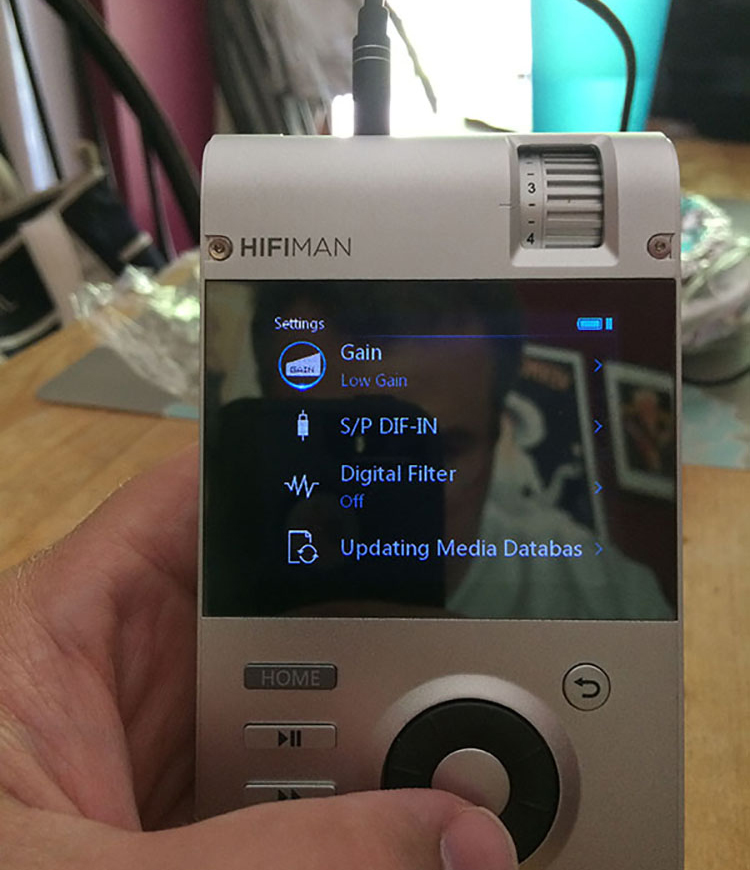While the current Digital Audio Player (DAP) market has a number of well-established players already out there, not to mention all the smartphones that do double duty as media players in the world, HiFIMAN looks to differentiate the HM901s with a focus on audio quality and a few novel technology twists. Featuring a unique, interchangeable amplifier card design, that can tailor output for many different kinds of headphones, and dual ESS9018 Sabre DACs for decoding music files, the HM901s sports some serious audio firepower to bring on your daily commute. When partnered with the separately available DOCK 1 as a base station, the basis for an elegantly simple home or desktop music system can be created.
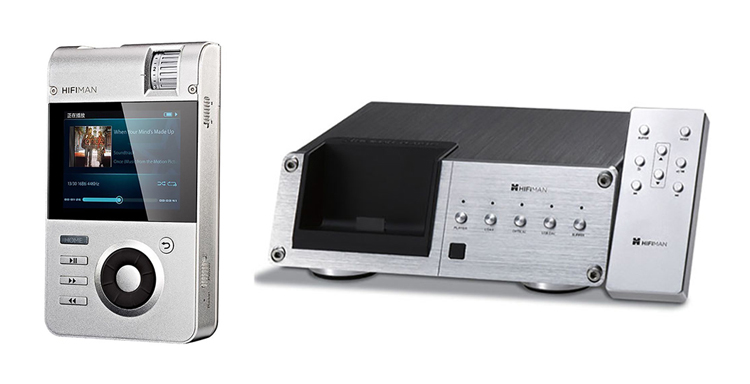
HiFiMAN HM901s Digital Music Player and DOCK 1
HiFiMAN HM901s Digital Music Player
- Clean, detailed high quality sound
- Plenty of gain, with included amplifier card, to drive higher impedance headphones
- Both balanced and unbalanced headphone jacks
- User replaceable battery
- Plays most common file types including DSD (.dff) files
- No permanent onboard storage. SD memory card (up to 256 GB) only (not included)
HiFiMAN DOCK 1
- Excellent build quality
- USB input for computer audio
- Has Coax and optical digital inputs and outputs.
- Selectable line output voltage to help mate with various preamps
I mostly use my iPhone 5s to play my music on the go. That’s just the honest truth. There are a number of IOS apps that will allow you to play FLAC and other, non-native iTunes ecosystem, files on the iPhone. There are some apps that will even allow DSD file formats to be played as well. I use the Onkyo HF Player app mostly as it’s wonderfully flexible and suits most of my needs. When I was younger, in the stone ages before cell phones were common, the only thing I carried around with me was my cassette Walkman. In fact, I went through several of them as you can see.
HiFiMAN HM901s Digital Music Player
Design:
Portable Digital Music Player
Codecs:
WAV, FLAC, PCM up to 24/192, DSD64 (DFF), ALAC (M4A), AAC, AIFF, MP3, WMA, OGG, APE
DACs:
Dual ESS9018S
Amplifier Card:
Balanced
MFR:
20 Hz – 20 kHz
THD:
0.008% (Line out)
S/N:
106 ±4dB
Dimensions:
1.1″ H (thickness) x 2.8″ W x 4.7″ D
Weight:
0.6 Pounds
Accessories:
Battery Charger, Line Out Cables, USB Cable, Mini Screwdriver
MSRP:
$1499.00 USA
HiFiMAN DOCK 1
Design:
Digital Music Player Base Station
USB Receiver Chip:
CMedia CM6631A
S/P DIF Input:
16/24bit, 44.1 – 96kHz
Dimensions:
2″ H x 5.1″ W x 6.1″ D
Weight:
1.5 Pounds
Accessories:
Remote Control, USB Cable
MSRP:
$499.00 USD
Company:
SECRETS Tags:
HiFiMAN, HM901s, DAP, Portable Music Players, Dock, DAC, HiFiMAN DOCK 1
Where to Buy:
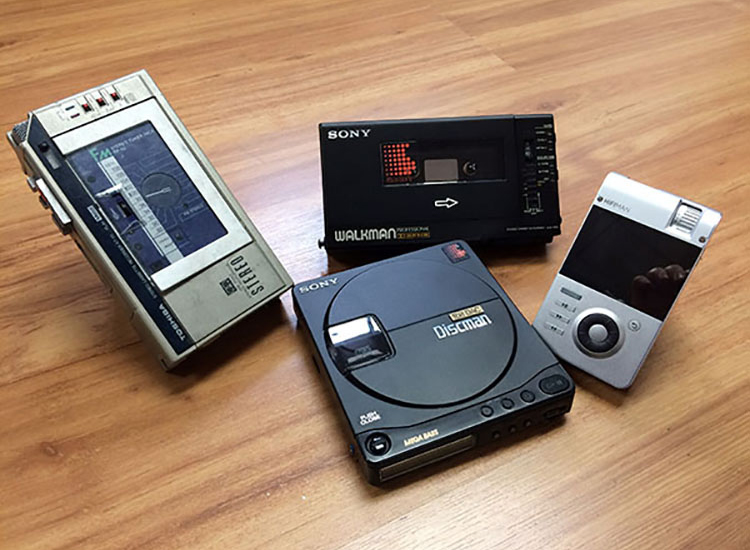
Some were very robustly sized, as was common at the time. Now though, I am a (supposedly) responsible adult with a family and a freelance career, and I need the ability to remain in contact with various individuals/clients at a moment’s notice. Plus….I still want my tunes with me.
My one little box from Cupertino (via a factory in China) does the trick these days. That’s convenience! It seems almost absurd to compare it to what I used to be willing to carry around in my youth! However, stubborn Neanderthal that I am, the one thing that will supplant convenience for me, is superior sound quality.
In order for me to be swayed to carry around another gadget just for my music, it needs to sound significantly better than what I’ve already got. And, face it, a modern iPhone coupled with a decent set of headphones, or IEMs, doesn’t sound half bad. This brings us to the HiFiMAN HM901s, a tidy but solid little brick of a player that purports to have some significant sonic chops.
Sporting, not one, but dual ESS9018 Sabre DAC chips, a high quality stepped potentiometer for volume control and a choice of interchangeable amplifier modules to best drive any given style of headphone (including high impedance and balanced), the HM901s doesn’t lack for interesting tech. HiFiMAN also sent along the DOCK 1 base station to show that, when combined, the two units can make a top notch music source for your home Hi Fi system.
Secrets Sponsor
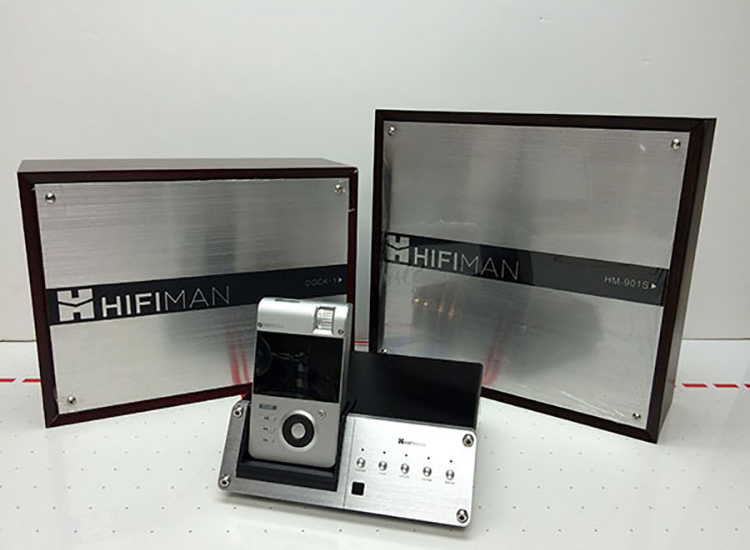
Both the HM901s and the DOCK 1 arrived at my home in spiffy wood presentation boxes with custom fitted inserts to keep all the goodies inside safe and sound. The HM901s itself fits pretty comfortably in hand and has a good solid heft to it.
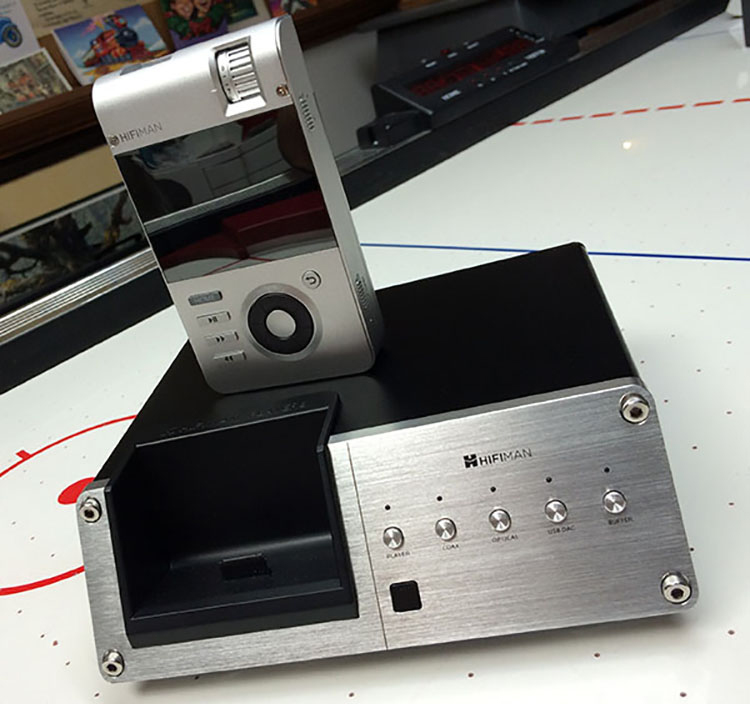
The weight of the thing makes it feel like you are holding a small aluminum brick or ingot which, while in hand, is great but when pocketed, can really weigh a little on lighter clothing. The main face of the player is dominated by a 2” x 1.25” active color display which showcases a fairly intuitive, albeit smallish, user interface. HiFiMAN calls the interface “TAICHI 2 UI.” It is a very clean and functional navigation system that takes virtually no time to get accustomed to and provides easy access to features, menus and music.

Below the display is the main navigation scroll wheel with a center selection button. The movement of the wheel is not completely smooth but is stepped to help tactilely sync with the UI selections. To the left of this are four, vertically arrayed buttons labelled (from top to bottom): Home, Play/Pause, Next Track and Previous Track. Just to the right of the scroll wheel is the Return button for going back through the menu items.
Above the display is a rather unique looking rotary volume dial that can be accessed with your thumb and forefinger through front and back openings. Called the Advanced Stepped Potentiometer, HiFiMAN claims to have spent significant design time to refine this volume control with specially matched resistors to improve channel balance and achieve more consistent attenuation levels across the dial. On the left side of the player is a rubber lift flap that covers the SD card slot.
The HM901s will play ball with cards up to 256GB in capacity, but in addition to the size of the memory card you choose, the speed class rating of the chosen card is important as well. I will touch upon this a little more later on in the review. There is no onboard memory available on the HM901s. On the right side of the player are two slide switches, one is a Hold switch which disables all the other control buttons except for volume, and the other is the main power switch which you slide and hold for 2-3 seconds to start up the player from a completely shut down state.
From a completely off state to being fully ready to play, the player requires about 30 seconds to boot up. There is also a small Reset pinhole switch to use if the player ever completely locks up for any reason. On the top side, the HM901s sports two headphone jacks, one marked Normal and the other marked Balanced.
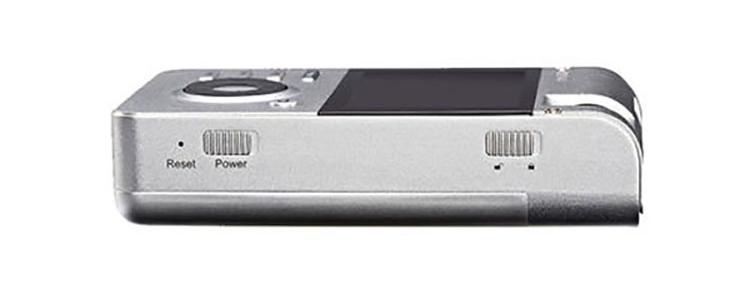
On the bottom of the player is a proprietary 24 pin connector port which interfaces with the included battery charge cable, line out cables (stereo L R and SPDIF), and the DOCK 1 itself. Flipping the HM901s over, you’ll find a removable panel that is secured by two small screws which can be removed with an included jeweler’s size Philips screwdriver.
With the panel removed we are granted direct access to the 7.4 volt, 2,000mA battery which HiFiMAN claims will run the player for approximately 9 hours before complete depletion. The battery can also be charged outside of the player, once removed, by using the included charge cable connected to an included battery dock. After carefully removing the battery we find the included amplifier card, installed in a similar fashion as would be a stick of computer memory in a laptop.
This particular card that is bundled with the player is the balanced model which provides output for both a standard and balanced pair of headphones. There are 4 other amplifier cards shown on HiFiMan’s website, each is designed to suit a different headphone type or output. All are available for individual purchase at an average price of $250.00 each.
This scenario could encourage third party vendors to design aftermarket amplifiers for the HM901s. It’s conceivable that an outside company could design a compatible amplifier card with a particular tuning to appeal to a given audience of listeners. Do you want a more “tube-like” sound? There could be a card out there for you!
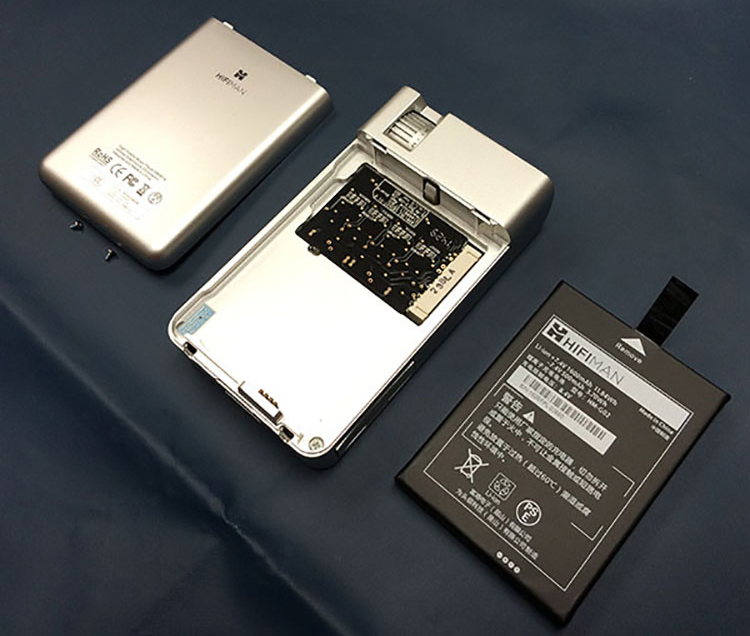
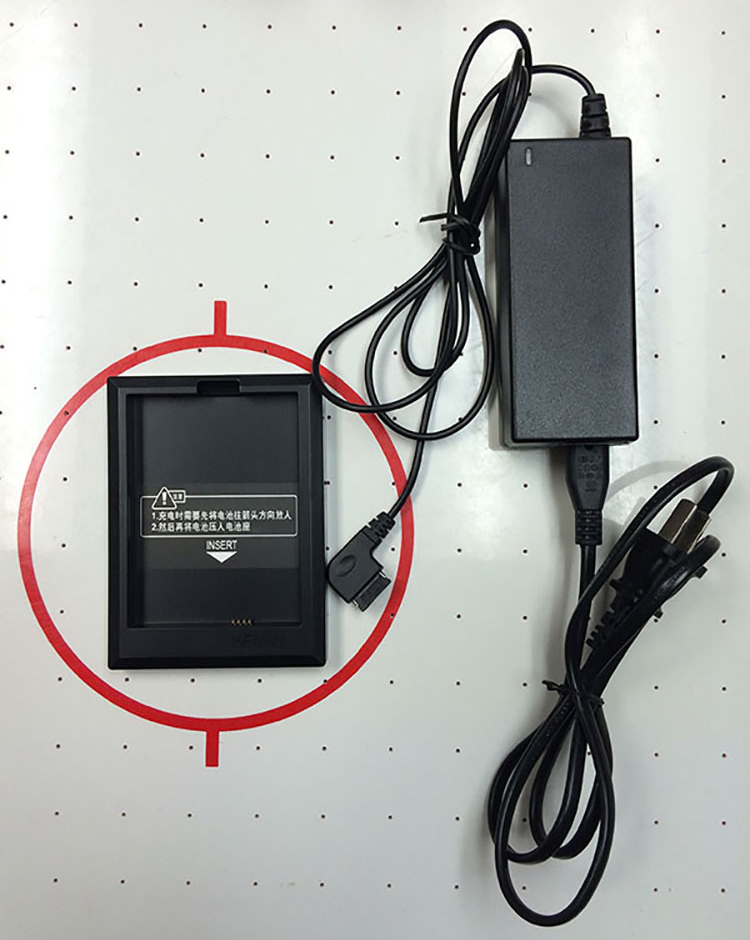
The DOCK 1 itself is a rather handsome looking unit that would look at home on either a desktop or in a home stereo system. It has a pretty milled aluminum faceplate that sports five horizontally arrayed buttons with corresponding indicator lights above each. The buttons are labelled: Player, Coax, Optical, USB DAC, and Buffer. Each input function is pretty self-explanatory except for the Buffer switch.
An email to HiFiMAN revealed that it adjusts the dock’s line output voltage from either 2.5 volts to 3.3 volts to help better mate with different components. On the backside of the DOCK 1 we have, from left to right: a grounded power socket with fuse, the master power switch, a digital coax output, a digital coax input, and a pair of stereo line output jacks. Just below these are a USB DAC input, a digital optical output, a digital optical input and a battery charger interface which is the same type of 24 pin port found on the bottom of the HM901s player.
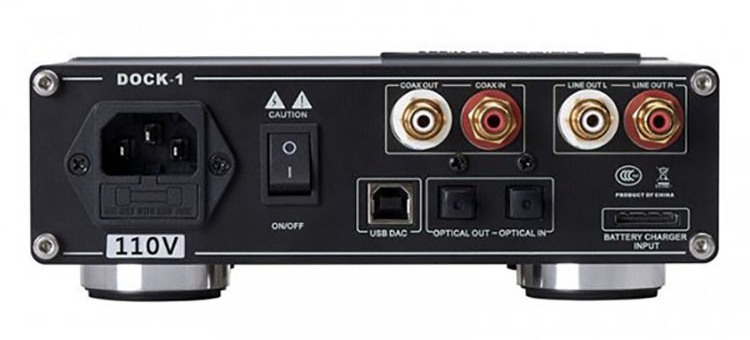
When using the DOCK1 as a USB DAC or while using any of the digital inputs, the onboard C-Media CM6631A chip acts as an audio receiver. It takes the incoming signal, converts the audio data to an i2s stream, where it travels to the DACs in the player for digital to analog conversion. The DOCK 1 will not function as a standalone DAC without a player, like the HM901s, attached. When a DAP is attached and the “Player” button on the DOCK 1 is selected, both the stereo line out and digital outputs become active and available for use. One thing I found odd about the DOCK 1 is that if you want to charge a player while its “docked” to the unit, that 24 pin port on the back of the DOCK 1 needs to be plugged into a second AC outlet.
For the majority of my testing, I used the HM901s with a variety of headphones including the OPPO PM-3, the HiFiMAN HE560, and the HiFiMAN HE1000. Direct comparison was made to my iPhone 5s using the Onkyo HF Player App. The DOCK 1 was connected into my existing studio 2 channel system consisting of: a Bryston BP 25 preamplifier, Marchand XM 44 electronic crossover, Marchand BASSIS parametric equalizer, 2 Carver TFM 55x power amplifiers, BESL Series 2 MTM monitor speakers, and twin custom sealed subwoofers with 15 inch Dayton Reference HF drivers.
Secrets Sponsor
Since this player uses an SD card for all its storage you can either load the card up with music by plugging it into a memory card reader or by plugging the player (with installed SD card) into a USB port. My home computer is a PC running Windows 7 and it had no problem recognizing the HM901s as a mass storage device when it was attached via its USB to 24 pin cable. I uploaded a variety of songs, mostly in the FLAC format (both in 16/44 and 24/96 and a few in 24/192), but I also included some AIFF files, some MP3s, and a few DSD files in the DFF format.
While the player will recognize DSD files in the DSF format, it will not play them. HiFiMAN states that they will be releasing a firmware upgrade down the road that will allow this to happen. I typically don’t upload entire albums to my media players, preferring instead to upload all my favorite tracks into one ginormous playlist and just hit shuffle. I equate it to having a giant, constantly changing, mixed tape!
The HM901s will allow you to access your songs through all the usual subcategories like, artist, genre, album, etc. with a turn of the thumbwheel. This arrangement allows easy, one-handed, navigation like iPods of yore. However, while the navigation was pretty easy and the UI was clean and responsive in general, the Now Playing screen itself was less successful.
The information on the screen was quite small and barely legible while album art was smaller than a postage stamp. As a matter of fact, there seemed to be little rhyme or reason as to which songs displayed album art and which didn’t. I know all my files are tagged with art and they all display cleanly on my iPhone, so I’m not sure what the issue is there.
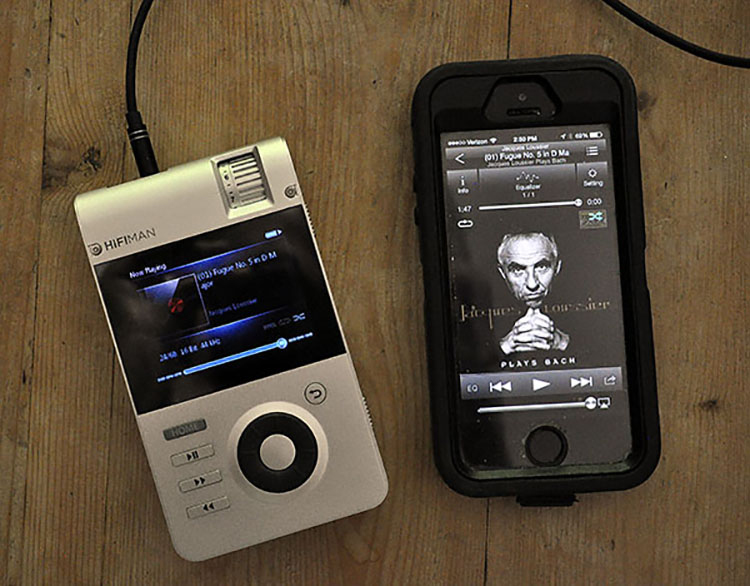
The Settings subcategory menu also has the usual selections that you would expect from a player of this caliber. It’s here where you will find the Gain- HI/LOW selector which you’ll want set to HI, as I did, when driving cans like HiFiMANs own HE560 and HE1000. The LOW setting was more than sufficient for the OPPO PM3s. The Gain control can also be accessed by pressing and holding the selection button in the center of the thumbwheel. A round, graphic submenu will come up that has Gain, Repeat, Shuffle, Trash, and Favorite selections offered up like pie pieces.
There are no EQ facilities on the HM901s, which doesn’t really bother me as I never use them on my iPhone, but I know some listeners find an equalizer useful for tweaking the sound depending on their headphones. Another option in the Settings menu, which I found less useful, was the Digital Filter selection. This is strictly an ON/OFF affair and, while it was mentioned in the manual, there was no explanation for what it did. An email to HiFiMAN revealed that when the filter was turned on, it would gently roll off frequencies from 10 kHz on up. Why you would want something like this in a high resolution player, personally, I do not know.
I’m guessing if you wanted to tame the high end on some less than great recordings perhaps? When I played around with it, I just felt that it flattened and dulled the sound of all the tracks I listened to, so I left it OFF. Now, in regards to the overall sound quality of the HiFIMAN player, it was truly impressive!
Listening through the OPPO PM3s (my usual mobile headgear) the HM901s was noticeably cleaner and richer sounding than my iPhone 5s. The twin ESS 9018 Sabre DACs ensured that vocal details, strings, and brass in particular all sounded better through the HiFiMAN. Decay of notes was also easier to make out as well. With the OPPO headphones and the gain set to LOW, the HM901s played more than sufficiently loud at number 5 on the volume dial.
Touching on the volume dial for a moment; I really appreciated its design and it felt substantial with a good overall tactile experience. However, as good as the OPPO headphones sounded with this player, the magic really happened when I substituted in the HE560 headphones that HiFiMAN graciously sent along with the player. Setting the gain to HIGH and plugging the headphones into the balanced jack resulted in playback quality that had been upped by good a few notches.
With a volume level of 7, the HM901s was putting out enough volume and power to drive the HE560s quite comfortably and most delightfully! My iPhone, on its own, couldn’t hope to touch this, with its meager power output making the HE560 sound kind of sad and underwhelming when I tried that combo together. I also had HiFiMAN’s flagship HE1000 headphones in for review and the HM901s drove them effortlessly as well. This combo provided probably the best quality sound that I’ve ever heard coming from a portable device.
FLAC rips of rock and roll classics like Bob Segar’s Ultimate Hits: Rock and Roll Never Forgets sounded fantastic with this HiFiMAN duo. It allowed me to fully appreciate the remastering job that been done on these songs, as I remember having some of Bob Segar’s first CD pressings from a few years back and they sounded flat and lifeless by comparison. My DFF files of Steely Dan’s Countdown to Ecstasy all played flawlessly and sounded as good as my SACD original.
In fact, just about everything I threw at this player generally played back flawlessly until I started playing files that were higher than 24 bit/96 kHz in resolution. I have a few music files encoded at 24 bit/192 kHz and when I tasked the HM901s to play them, the playback would start to stutter about a quarter of the way through each track. Also, on two occasions the player froze up completely and I had to initiate a hard reset via the pinhole button on the lower right side. Unable to get these files to playback smoothly after a number of attempts, I contacted HiFiMAN and they stated that because of the data bandwidth that 24/192 files require to play, a very fast, high quality SD card is needed for those tracks to playback smoothly.
Throughout my review, I had been using a Samsung 64GB Class 10 SD card for my tests, and while it’s not the fastest card in the world, it’s not pokey by any stretch either. This leads me to my biggest concern with the HM901s. The fact that after one pays almost $1500.00 for a state of the art music player, another $50.00 at least will have to be dropped for a 64GB memory card fast enough to play the highest resolution files.
If you want even more storage, like 128GB or 256GB, get ready to spend more still. While this situation is not the end of the world, it is a little bit tough to swallow. On the other hand if having the sound quality of a fine home stereo component, in your pocket, is your prime concern then these quirks may be insignificant to you. Battery run time is specified to be approximately 9 hours on a full charge. I ran the player from full to dry a number of times and I consistently got about 8.5 hours’ worth of use. Quite satisfactory indeed.
The DOCK 1 was connected to my Bryston BP-25 preamp via its L/R RCA outputs. The standard 2.5V output voltage was already plenty strong enough to mate well with my preamp. Switching to 3.3V using the Buffer button just made things sound louder so I just left the setting alone. As an intermediary between the digital player and my stereo, the DOCK 1 did an admirable job relaying the pristine sound quality of the HM901s through to my speakers. The included mini remote control is simple, handsome and does its job well with the basics of navigation, volume, muting and such. And while I didn’t spend a large portion of time listening to other devices through the DOCK 1s digital inputs, I did connect a cd player to it via both optical and coaxial digital inputs.
The DOCK 1 locked on and decoded the data stream without issue. The signal, decoded through the twin Sabre DACs of the attached HM901s, sounded quite decent in its own right. I did not have the opportunity to try the USB input. The DOCK 1 does, however, have a couple of quirks that do need to be mentioned. As I alluded earlier, the DOCK 1 won’t charge the HM901s while attached without additionally connecting the player’s charger cable to the back of the dock.
This means you are using up 2 power outlets for essentially one component. Also, because of the location of the power button on the HM901s, you can only shut the player down through navigating to the settings menu via the thumbwheel when docked. Neither of these things are really a big deal, but they are just slightly unusual. The one missing feature that I think could make the HM901s/DOCK 1 combo more user friendly in a home stereo setting would be some sort of way to output the video of the tiny navigation screen to a TV monitor.
Another idea could be a dedicated smartphone app to control HM901s while docked. This would go a long way to make the navigation so much easier to see from the comfort of your chair as opposed to having to get up and squint at the display to see what track is next. Again, though, if top drawer sound quality is your prime concern, these issues may not matter at all and if using the combo as a desktop system, you’re close enough that it makes the lack of video output a moot point.

THE HIFIMAN HM901S DIGITAL MUSIC PLAYER has Great Battery Life.
- Excellent sound quality
- Great battery life. Being user replaceable is also a plus!
- Ability to drive a variety of headphones including some high impedance cans
- Multiple file support, including some DSD
- Bigger screen and/or better use of current screen real estate
- More consistent display of album art with tracks
- Switch from SD card to faster on-board memory or at least a memory buffer system to remove stuttering playback with some high bitrate files
- Video output from DOCK 1 to display menu and navigation onto a TV or a dedicated smartphone app for control
- Remove the need of a second power cable to charge the player when docked in the DOCK 1
- More detail and explanation in the user manuals about some of the features
I thoroughly enjoyed my time with the HM901s. With its impeccable sound quality, solid build, extensive file format support (including some DSD files) and capacious battery, it ticks all the main boxes for an on-the-go audiophile’s dream. Add to that, the power and flexibility to tune the output for various types of headgear via the amplifier cards, and you’ve got something a bit more special than just your average, run-of-the-mill digital audio player.
The fact that you have to purchase a fast, high quality SD memory card to play the highest bitrate files without stuttering is a bit of ding on its, otherwise, strong performance and feature set. Add the $499.00 DOCK1 to the mix and you have yourself a sharp and tidy desktop or home source component that is flexible and will rival the sound quality of much pricier gear. Man, we have come a long way from the days of cassette player and CD Walkmans!



